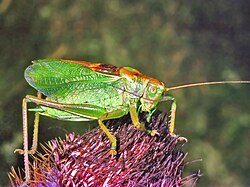| Tettigonia cantans | |
|---|---|
 | |
| Tettigonia cantans, male | |
 | |
| Female | |
| Scientific classification | |
| Kingdom: | Animalia |
| Phylum: | Arthropoda |
| Class: | Insecta |
| Order: | Orthoptera |
| Suborder: | Ensifera |
| Family: | Tettigoniidae |
| Genus: | Tettigonia |
| Species: | T. cantans |
| Binomial name | |
| Tettigonia cantans (Fuessly, 1775) | |
| Synonyms | |
| |
Tettigonia cantans is a species of bush crickets (or katydids) belonging to the family Tettigoniidae subfamily Tettigoniinae.



